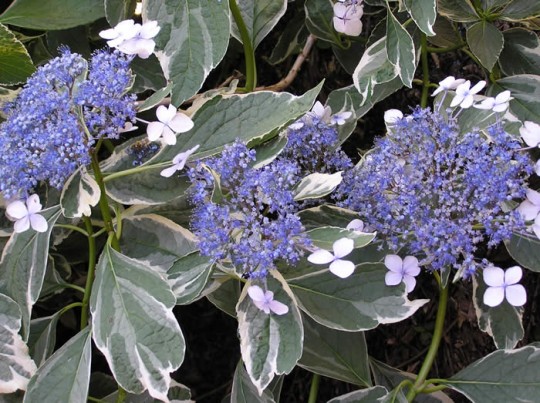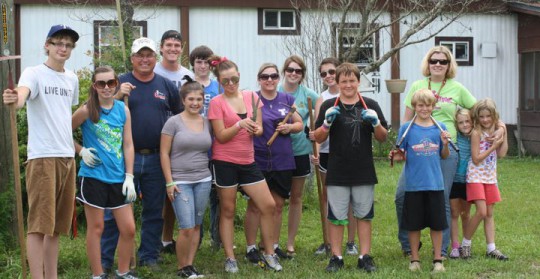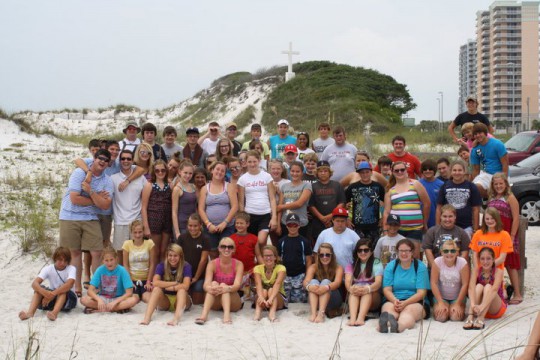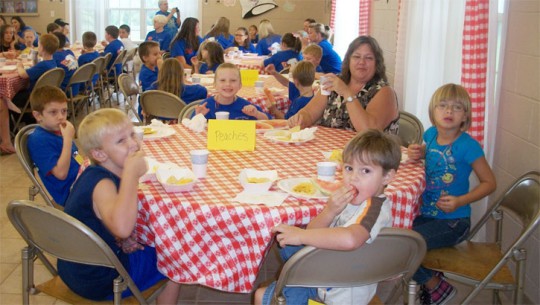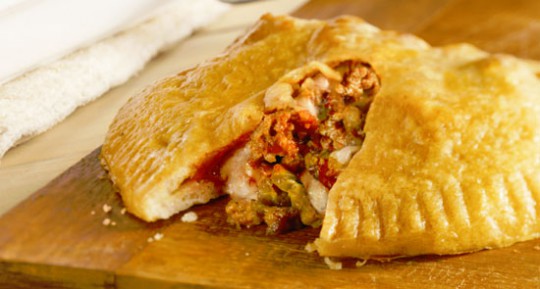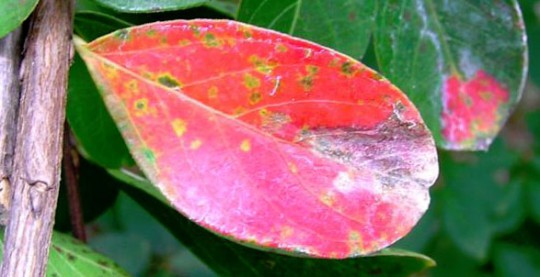Molino Homemakers Create Bibs For Rehab Patients
July 31, 2011
The Molino Homemakers recently made adult-size bibs for rehabilitation patients at West Florida Rehabilitation Institute.
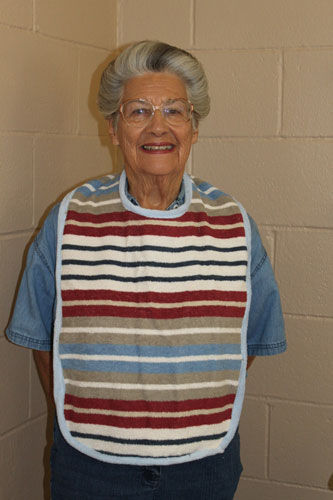 Club President Nancy Holland set up a station where members cut out terrycloth and plastic material from a paper bag pattern. At another station, the plastic and terrycloth pieces were pinned then sewn together. Other members trimmed and turned the bibs then the bottoms were hand stitched closed.
Club President Nancy Holland set up a station where members cut out terrycloth and plastic material from a paper bag pattern. At another station, the plastic and terrycloth pieces were pinned then sewn together. Other members trimmed and turned the bibs then the bottoms were hand stitched closed.
Holland delivered the completed bibs to patients who undergo rehabilitation from strokes and other illnesses or surgeries. The patients are able to take their bib home with them once they leave rehab.
The Molino Homemakers meet on the first Wednesday of each month (except July) at 10 a.m. at Aldersgate United Methodist Church in Molino. The next meeting will be August 3. Visitors are welcome; dues are $5 per year.
Pictured top: Members of the Molino Homemakers create bibs for rehab patients. Pictured inset: Club member Shirley Clayton models a bib. Submitted photos and story by Terri Brown for NorthEscambia.com, click to enlarge.
Featured Recipe: Mexican Lasagna
July 31, 2011
Today’s featured recipe for Mexican Lasagna will add new flavors to family mealtime as an old favorite gets a south of the border twist.
Mexican Lasagna
Ingredients
- 1 can (10 3/4 ounces) Campbell’s Condensed Cheddar Cheese Soup
- 1/4 cup milk
- 1 package (about 1 ounce) fajita seasoning mix
- 1 pound ground beef
- 1 can (10 3/4 ounces) Campbell’s Condensed Golden Mushroom Soup
- 1/2 cup water
- 1 tablespoon chili powder
- 1 1/2 teaspoons dried oregano leaves, crushed
- 12 corn tortillas (5-to 6- inch)
- Chopped tomatoes (optional)
- Sliced green onions (optional)
Preparation
- Stir cheese soup, milk and half the fajita seasoning in medium bowl until mixture is smooth.
- Cook beef in a 10-inch skillet over medium-high heat until well browned, stirring often to separate meat. Pour off any fat.
- Stir mushroom soup, water, chili powder, oregano and remaining fajita seasoning in skillet and heat to a boil. Reduce heat to low. Cook for 5 minutes. Remove skillet from heat.
- Place 3 tortillas in the bottom of a 2-quart shallow baking dish, overlapping slightly. Spread 1 cup beef mixture over the tortillas. Repeat layers twice. Top with remaining tortillas. Spread the cheese soup mixture over the tortillas.
- Bake at 350°F. for 30 minutes or until hot and bubbling. Let stand for 10 minutes. Sprinkle with the tomatoes and onions, if desired.
Serves
Makes 6 servings
Preparation Time:
20 minutes
Bake Time:
30 minutes
Standing Time:
10 minutes
Weekend Gardening: Distinctly Southern Hydrangeas
July 30, 2011
Photo by Mandy Fails of Atmore for NorthEscambia.com, click to enlarge.
Nothing defines a southern landscape more than hydrangeas.
 These beautiful, large flowering shrubs fill gardens with their green, leafy foliage and incredible blooms during the warm months.
These beautiful, large flowering shrubs fill gardens with their green, leafy foliage and incredible blooms during the warm months.
In order to ensure consistent and reliable blooms, these shrubs must be cared for correctly. In addition to proper site location, fertilizer and moisture conditions, hydrangeas may require pruning. Proper pruning includes correct timing.
Hydrangea aficionados are constantly debating pruning techniques. There are many different types of hydrangeas and pruning differs according to the type. It is a big genus of plants and so it’s important to know what type of hydrangeas you may have and on what type of wood they bloom on.
Blooms on old wood, prune after flowering
The bigleaf hydrangeas, known scientifically as Hydrangea macrophylla, are what most people think of when you mention hydrangeas. Most gardeners will know these as mopheads (also called hortensias) and lacecaps. Many of these blooms will be blue or pink although other colors now are available.
Many large colonies of bigleaf hydrangeas have existed around old homes for decades, surviving and blooming in spite of neglect. This tells us that it is not necessary to prune bigleaf hydrangeas.
However, if you want to keep these shrubs within a defined boundary, control their height or rejuvenate old shrubs, it will be necessary to prune them.
Bigleaf hydrangeas can be reduced in size immediately after flowering. A general rule of thumb is that you may remove up to a third of the shrub’s height. Be sure to complete your pruning before August. This is critical because next year flower blooms start to form in August. Pruning after August will remove next year’s blooms.
There now is a small group of bigleaf hydrangeas that are everblooming or remontant. Endless Summer® is one well-known brand. According to the developers of these reblooming hydrangeas, remove spent flowers to encourage rebloom. They are quite forgiving and will not suffer if left unpruned or pruned at the wrong time because these cultivars bloom on both old and new growth.
Our native oakleaf hydrangea (Hydrangea quercifolia) is a large, deciduous shrub that can grow up to six feet tall. It has deeply lobed, oak-like leaves which turn bronze in the fall. This plant does not usually need pruning. If reshaping or size-reduction is necessary, prune after blooms begin to fade.
Article Continues Below Photo
Lacecap hydrangea Photo credit: Theresa Friday
Blooms on new wood, prune in early spring
Smooth hydrangea (H. arborescens) is the other U.S. native. The most common cultivar, ‘Annabelle’, produces rounded inflorescences that may reach up to a foot in diameter.
The panicle hydrangea (H. paniculata) is more of an upright type. It is typically a 10 to 15-foot large shrub or low-branched tree.
Panicle and smooth hydrangeas flower on current year’s growth and can be pruned anytime from late summer until early spring. If pruning these two species in the spring, try to prune before leaves appear.
Winter pruning
Established bigleaf, panicle, oakleaf and smooth hydrangea plants can often benefit from rejuvenation pruning. Remove about one-third of the oldest stems each year. The result is a fuller, healthier plant. This type of pruning is easiest to do in winter, since the absence of leaves makes it easier to see and reach inside plants.
Hydrangeas offer a wide variety of plants which can make the timing of pruning difficult to remember. Just keep in mind, if in doubt, either don’t prune at all or prune after flowering.
Theresa Friday is the Residential Horticulture Extension Agent for Santa Rosa County.
Century Turns Out To Give Blood
July 29, 2011
 Several Century area residents turned out at a town-sponsored blood drive Thursday afternoon.
Several Century area residents turned out at a town-sponsored blood drive Thursday afternoon.
“We always give,” said Paula Hammond as she arrived with friend Cheryl Stacey as the Northwest Florida Blood Services Bloodmobile opened for donors at the Century Town Hall.
Century Street Superintendent Larry Murphy was among those that turned out, donating in honor of his brother.
The blood drive netted 15 donors, according organizers, toward a critical need for blood in the area.
Pictured top: Kelvin “Batman” Hyman (left) and Cesar Gonzalez during a blood drive Thursday afternoon in Century. Pictured inset: Cheryl Stacey (left) and Paula Hammond were among the donors. Pictured below: Street Superintendent Larry Murphy donated in honor of his brother. Submitted photos for NorthEscambia.com, click to enlarge.
Photos: Mission Molino
July 28, 2011
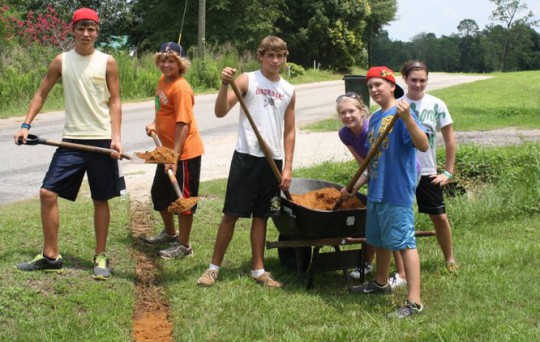 There’s a group of youth in Molino that are on a mission this week.
There’s a group of youth in Molino that are on a mission this week.
The youth from Highland Baptist Church have been joined by youth from Friendship Baptist Church from Cleburne, Texas, for “Mission Molino”.
Monday, about 60 youth along with adult volunteers worked to paint and do yard work for eight widows in Molino. Tuesday, they headed to Pensacola Beach to pass out water bottles and Salvation bracelets. During the remainder of the week, they will volunteer at the Florida Baptist Children’s Home and create activity packs for children at Sacred Heart Children’s Hospital.
For a photo gallery, click here.
Pictured above: Youth involved in Mission Molino did yard work for eight widows on Monday. Pictured below: The students took part in a Mission Molino project on Pensacola Beach. Submitted photos for NorthEscambia.com, click to enlarge.
Photos: Aldersgate UMC Shake It Up Café VBS
July 26, 2011
The “Shake It Up Café” Vacation Bible School is underway this week at Aldersgate United Methodist Church in Molino.
The VBS is open to children ages 3 through the fifth grade from 5:30 until 8:30 nightly through Friday. Dinner is served each evening.
“At Shake It Up Café, everyone will enjoy a kid-friendly café full of chef’s hats and aprons, pots and pans, checkered tablecloths, and chalkboard menus,” said Sandra Greenwell, Aldersgate’s VBS director. “We will explore the Bible as a cookbook filled with recipes for living out God’s Word.”
For more photos from the Aldersgate United Methodist Church VBS, click here.
Pictured above and below: VBS at Aldersgate United Methodist Church in Molino. Submitted photos for NorthEscambia.com, click to enlarge.
Do you have news or photos you would like to share from your church? Email news@northescambia.com
Gudell, Amerson To Wed
July 24, 2011
 Mr and Mrs Floyd Gudell of Molino announce the upcoming marriage of their daughter, Layla Ann Gudell, to Brian Matthew Amerson, son of Mr and Mrs Rick Amerson of Century.
Mr and Mrs Floyd Gudell of Molino announce the upcoming marriage of their daughter, Layla Ann Gudell, to Brian Matthew Amerson, son of Mr and Mrs Rick Amerson of Century.
Both are graduates of Northview High School and Mr. Amerson is a graduate of Pensacola State College. Ms. Gudell is currently attending PSC.
The ceremony will take place at The Barkley House on July 30, 2011.
Birth: Lillie Marie Murphy
July 24, 2011
 Willie and Christina Murphy of Pensacola are proud to announce the birth of their daughter, Lillie Marie Murphy.
Willie and Christina Murphy of Pensacola are proud to announce the birth of their daughter, Lillie Marie Murphy.
Lillie came into the world on July 8, 2011, at 11:53 p.m. She weighed 8 pounds, 1 ounce. Paternal grandparents are Wanda Pittman Murphy and Gary Sunday of Pensacola. Maternal grandparents are Terry and Mary Freeman of Walnut Hill.
Featured Recipes: Mexican Sausage Pizza, Sausage Mushroom Calzone
July 24, 2011
A busy life does have to put a damper on dinner plans with these two simple recipes — Mexican Sausage Pizza and Sausage and Mushroom Calzone.
(Scroll down to see both recipes.)
Mexican Sausage Pizza
Prep time: 20 minutes
Cook time: 10 minutes
Makes 4 servings
1 pound roll sausage (can use hot)
3 cups baking mix
2 cups grated cheddar cheese
1 can (15 ounces) refried beans
1/2 cup chopped onion
1 cup diced tomato
1/2 cup minced cilantro
2 cup shredded Mexican blend cheese
Sour cream (optional)
Salsa (optional)
Preheat oven to 350°F.
In medium skillet over medium heat crumble and cook sausage until brown. Cool.
In large bowl, combine baking mix, cheddar cheese and cooked sausage. Stir in 5 or 6 tablespoons water to form a dough. Pat out into a thin layer on a large baking sheet or pizza pan. Bake for 10 minutes or until light brown.
Spread crust with refried beans. Top with onions, tomato, cilantro and cheese. Bake for an additional 10 to 15 minutes or until cheese is melted.
Sausage and Mushroom Calzone
Prep time: 20 minutes
Cook time: 20 minutes
Makes 4 servings
1 pound Italian sausage
1 pound loaf frozen bread dough, thawed
1/2 cup pizza sauce
1 jar sliced mushrooms, drained (4 ounces)
1/2 cup grated mozzarella cheese
Preheat oven to 350°F.
In large skillet, crumble and cook sausage until browned. Set aside.
Roll out dough on lightly floured surface to 12- to 14-inch rectangle. Cut into 4 pieces.
Top half of each rectangle with sauce, sausage, mushrooms and cheese. Fold dough over to enclose. Crimp around edges with a fork. Place on lightly greased baking sheet. Bake at for 20 – 25 minutes or until golden brown.
Weekend Gardening: Seeing Spots On Your Crape Myrtles Can Be A Problem
July 23, 2011
 As the heat and humidity increases in Northwest Florida, expect to see some diseases appear in the landscape. One problem that is popping up on crape myrtles is Cercospora leaf spot. While not a deadly problem, it can greatly detract from the beauty of crape myrtles.
As the heat and humidity increases in Northwest Florida, expect to see some diseases appear in the landscape. One problem that is popping up on crape myrtles is Cercospora leaf spot. While not a deadly problem, it can greatly detract from the beauty of crape myrtles.
The initial symptom on crape myrtles is the appearance of tan to dark brown spots randomly scattered on yellow to red discolored leaves. The spots develop first on the lower leaves and progress upward in the canopy. Spots will continue to develop from mid-summer through fall. The color change is due to the production of a toxin by the fungal pathogen.
Infected leaves will drop prematurely and serve as a source to spread the pathogen causing further disease development. As the summer progresses, many infected trees will have dropped all but the newest leaves.
Older varieties of crape myrtles are more susceptible to this disease than newer varieties. The crape myrtle varieties most tolerant to Cercospora leaf spot are Natchez, Muskogee, Basham’s Party Pink, Sioux and Tonto.
Long term, this disease is not detrimental to a tree, although it will slow down growth on younger plants. Plants growing in conditions that are not ideal will be more affected by the leaf spot disease.
The best control is selecting a planting site with good air circulation so that the foliage will dry quickly. Thinning interior branches will also promote air flow.
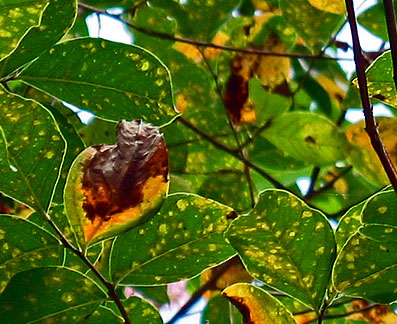 The use of fungicides to control this disease has not been very effective because they would have to be applied repeatedly on a regular basis throughout the growing season. If used, fungicide applications should be started in early summer when the spots are first noticed and continued at one to two week intervals when the weather is warm and wet. Consult your local Extension office for fungicide recommendations.
The use of fungicides to control this disease has not been very effective because they would have to be applied repeatedly on a regular basis throughout the growing season. If used, fungicide applications should be started in early summer when the spots are first noticed and continued at one to two week intervals when the weather is warm and wet. Consult your local Extension office for fungicide recommendations.
As always, be sure to read and follow all label directions. Fungicides can be classified by how they work on the fungus or how they work on the plant. Products that work in a similar way on fungi have the same mode of action (also referred to as chemical family or class).
Contact fungicides are sprayed onto plants and act as a protective barrier from pathogen infection. They prevent infections from occurring when applied before symptoms are visible, but infections that have already occurred will continue to develop.
Systemic fungicides move into the plant, but movement inside the plant is limited. The vast majority of fungicides only move upward in the plant vasculature, but not down. Some fungicides only move locally into the plant part treated. Some systemic products exhibit curative action, which means the disease is stopped during its development. For managing fungicide resistance, products with different modes of action should be used in rotations.
Since this disease will result in early defoliation or the loss of leaves, it is critical to practice good sanitation. Raking and destroying fallen leaves should be a routine practice in order to prevent the spread of the disease.
For more information, contact Theresa Friday at 850-623-3868 or email tlfriday@ufl.edu. Friday is the Residential Horticulture Extension Agent for Santa Rosa County.





